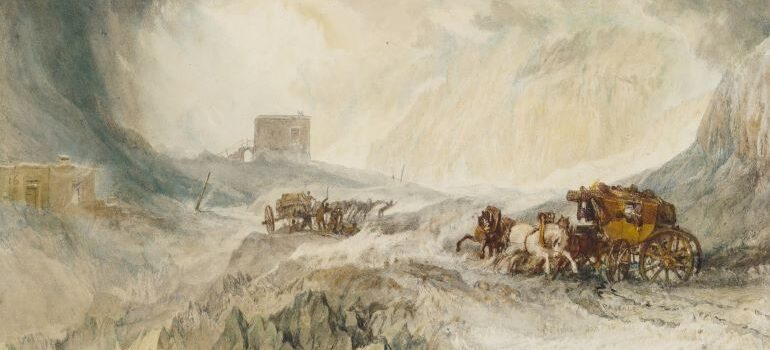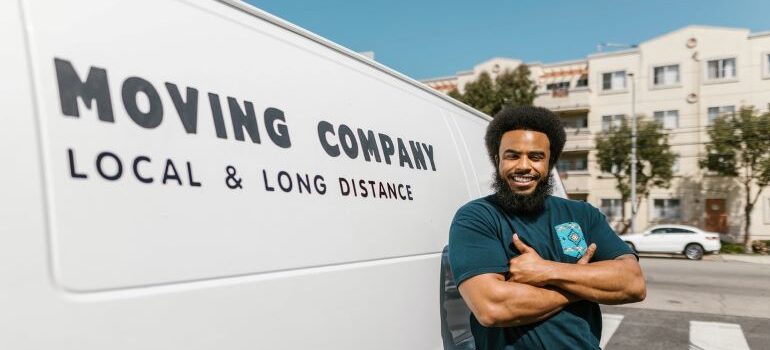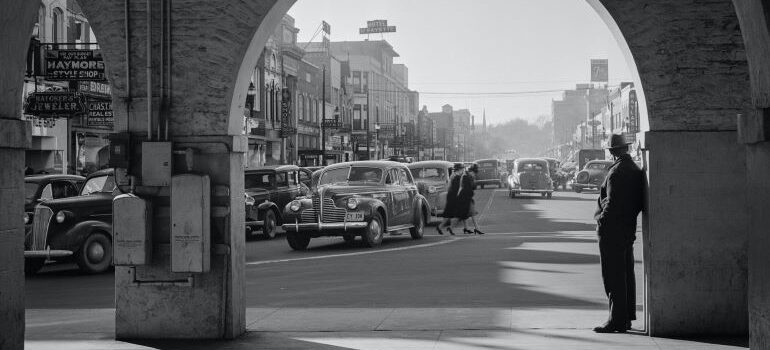Then & Now: The history of moving companies
Although the moving industry as we know it today is a relatively new one, people have been relocating since the dawn of humanity. And there weren’t always moving businesses such as Best Cross Country Movers around. For thousands of years, humans relied on their own resources to transport themselves, their families, and their possessions across the enormous geographical masses of the Earth. This has been happening since we as a species opted to leave Africa in the first place. If you want to learn something more about how people used to move across the world, the origins of the moving industry, and the history of moving companies, just keep reading this article.
How did our ancestors move?
For much of human history, the world enjoyed hosting men who did not have many possessions at all. A man would walk with just a few animal skins and some hunting equipment. The man had to live simply and lighten his load during the entire hunting season and even after that. With no moving trucks or professional residential movers, he had to bring back his feast, sometimes quite heavy, back home himself. On foot. But soon, his life would become easier.

As farming developed, mankind started to settle down for a bit. They will stay with their families in one location for an extended period of time and they began building larger houses and collecting more belongings to fill them. Unfortunately, since no one had created the wheel yet, they couldn’t move so easily. And the moving industry could not capitalize on the ripeness of the moment.
The Travois: An Ancient Means of Transportation
However, many did relocate. Instead of calling New York movers and heading for the skies, they employed two long wooden poles that were dragged around the ground by the family donkey – or ox – as a travois. Everything the family has would be slung between these two poles and fastened to the supports. It didn’t look good, but it got the job done. Both ends of the relocation created two large ruts in the person’s front yard.

French for work is travois, of course. For a device that would boost the moving business, a moniker that implies a “painfully arduous or heavy job” makes sense. Even when the wheel and the axle were discovered, the travois was still superior to a wheeled cart since there was no paved road.
People then started living in a hierarchical society. And as humanity progressed, the misery of those working for kings and queens was born. The wealthy elite would have their slaves and nannies, and maids move their gold goblets, silk robes, marble sinks, and exotic animal hides. These “movers” had a very hard time doing that. But soon, their successors would enjoy a higher standard of living with new discoveries.
Covered Wagons in the American West
At the beginning of the 19th century, the covered wagon was introduced to the American landscape for the first time. In spite of its legendary status, the Conestoga had no role in the vast westward advance. The developing transportation business, however, benefited greatly from this massive vehicle. There are no exaggerations in our definition of huge. These hand-crafted wooden vehicles could haul up to six tons of cargo. Curved floor sections at both ends helped keep cargo from moving or falling out of the Conestoga wagon. This made it difficult to secure the load. But there were gates on the wagon’s ends that could be lifted and lowered with a chain, much like the tailgate of the pickup truck your buddy believes is enough for a cross-town relocation. But it is not. However, Colorado movers would probably have something more suitable.
Many farmers used the Conestoga as a means of transporting their harvests to the metropolis, as well as bringing back goods that were only accessible in the towns. This included trendy clothing and good beer. Nevertheless, these carts proved to be too cumbersome and heavy to be useful across long distances of tough terrain. Instead of the Conestoga SUVs, passengers heading west utilized covered wagons with flatter bodies and lower sidewalls. The white canvas coverings of the wagons supposedly resembled the sails of ships from a distance, so they were referred to as Prairie Schooners. As if today’s tractor-trailers that our movers California have been being referred to as “Highway Barges.”
Modern Truck vs Covered Wagon
The covered wagon has has a great impact on the history of moving companies. Covered wagons, surprisingly, featured many of the same features of today’s tractors and vehicles. There is no evidence that the wagons were equipped with spare wheels, although they did sometimes have an extra axle in case one broke during the harrowing journey. This extra axle may break at any time, requiring the movers to locate a tree (ideally oak or maple) and chop a new one. If our spare tire blows up, all we have to do is call AAA – which, come to think of it, may wind up taking longer than locating a rubber tree and manufacturing a new tire.
What features did the covered wagon have that the modern truck doesn’t?
- A unique feature of covered wagons was that their wooden brakes never caught fire. We use high-tech materials in our vehicle brakes these days, and they do catch fire.
- A covered wagon would usually have some extra supplies hidden in there (weapons). That is very much forbidden in modern trucks. But to be fair, it’s unlikely that we will run into wild animals or other enemies on the road nowadays.
- The covered wagon usually had wood for cooking and some axles, as well as food, medicine, and camping gear fastened to the underbelly of the vehicle at all times for emergencies.
- For longer trips, our ancestors needed more gear and supplies. So this forerunner of a modern belly box sometimes wasn’t enough. That’s when they came up with the wagon trains. This gave them much more storage space.

Today’s version of the wagon trains
It’s hard to pin down today’s version of the wagon train. Since there’s not really a need for it anymore. Most movers Pennsylvania nowadays would just use a larger truck if they need to load a lot of stuff. The convoys, similar to the wagon train, are not really used anymore. Although it was popular in the early 1920s. Today we have truck stops and gas stations for getting supplies so we don’t really need an extra wagon. The CB might be the most similar thing to the wagon train. Truckers sometimes use it to speak with other truckers to warn each other of the risks of police, road hazards, and open weigh stations.
Back then, a family traveling, let’s say from Independence, Missouri to Oregon on the Oregon Trail in the 1840s reportedly took between four and six weeks by covered wagon. To put it another way, it’s approximately how long it currently takes for certain van lines to locate a driver for their cargo or a vehicle for their consignment. But with our Missouri movers, you can move across the country in just a matter of hours.
The history of moving companies
The moving business is a relatively recent phenomenon. It’s common knowledge that the term “moving industry” refers to commercial companies that provide moving services to those who need to relocate locally or internationally. It’s vital to note that we’re referring to private companies that can provide moving services to anybody in the world, no matter where they are located.
Some historians incorrectly claim that the moving business has been around for hundreds of years. This is, of course, false. Obviously, humans have been migrating from the beginning of time as we mentioned. However, there were no private businesses operating back then. The whole story started with the construction of railways in the United States of America. This is the starting point of modern moving companies.
The first moving companies
The services offered by the initial moving businesses were quite restricted. It’s because their routes weren’t well established and they didn’t have the necessary tools. To begin with, in the 19th century, Americans used trains to move their possessions about. The covered wagons, we mentioned above. Indeed, the United States was the first country to introduce transportation. Because you couldn’t specify exactly where you wanted your stuff to be transported, using the carts was quite restricted. Moving firms were initially transferring goods from a nearby warehouse to another. Surely, this isn’t a huge issue. Transporting back then was very time-consuming.
Regardless, this was the first-ever moving business. At that time, moving from one city to another was possible for anybody with enough money. But, as you can guess, not a lot of people could afford it. Many would still move by themselves.
The revolution that transforms moving services
Shortly, the moving company became a much larger enterprise. Motor vans were introduced. The transition from trains to motor vans was nothing short of revolutionary. This is one of the most important events in the history of moving companies. When that happened, the demand for moving services skyrocketed to unprecedented levels. As a result of the rapid advancement in technology, an increase in the number of trains and new highways, and people’s unique need to relocate, it was now possible to relocate homes. In the mid-20th century, motorized cars became an essential aspect of transportation.
Immediately after the introduction of automobiles to the transportation business, it grew at an incredibly rapid pace. The so-called “pack and move” service, which is now a common thing, was introduced by new businesses.
The moving industry as we know it
There is a moving business on about every corner these days. An estimated 40 million Americans relocate each year, according to the U.S. Census Bureau. These figures include both local and long-distance movements. According to the research, DIY (do-it-yourself) moves account for the vast majority of all relocations. The moving industry is now one of the world’s biggest industries.
Despite the long history of the moving business, it wasn’t until recently that fraud began to appear. The internet made it easy for pretty much anyone to start their own company. Some of them are scammers trying to get you. However, most movers are competent and closely regulated. If you do some basic research and don’t only focus on the lowest price, you can easily avoid being taken advantage of.
Nowadays, you’re able to move pretty much anything. Whether you are moving locally or long-distance, your home or your office, there are specialized moving services for all kinds of moves. And it’s so easy to find the ideal movers. All you need to do is make a few calls or send an inquiry through your mover’s webpage.

With commercial moving services, you are able to move whole businesses and entire buildings in just a matter of hours. Many businesses even offer packing services, so you don’t have to make your employees do it. Professional movers are able to move anything from your office furniture to IT equipment, and they will tend to your moving needs with utmost devotion.
Final notes
We hope you’ve enjoyed learning a little more about the moving field and its history. The history of moving companies is truly fascinating, and it’s made our lives thousand times easier. Today, you’ll have so many choices and you are able to move anywhere around the globe thanks to the existence of international moving companies. You can move your whole household cross-country and overseas, and thankfully, we’ve come to the point where you don’t have to spend a fortune to do it.






